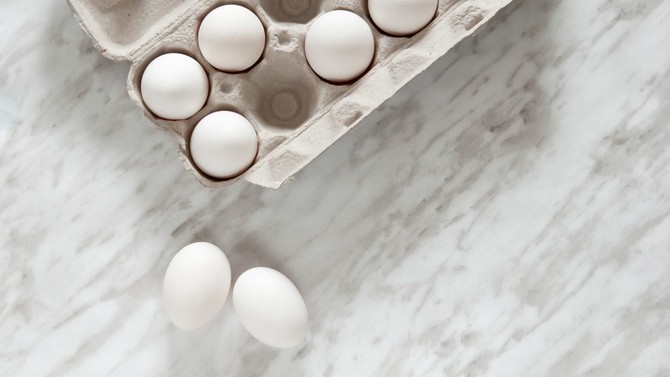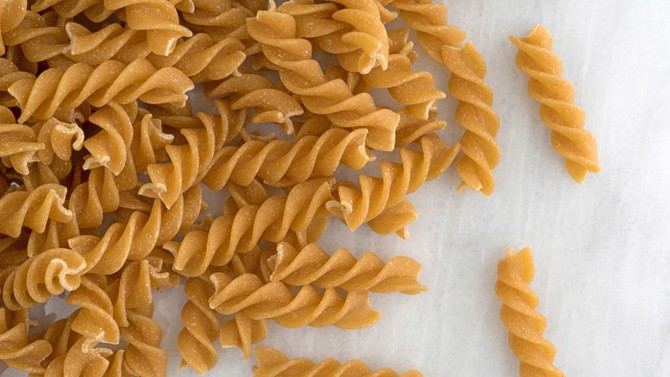The Ultimate Guide to Meal Prep
Here are 24 simple do-ahead tasks. Just pick as few, or as many, as you have time for on a Sunday, and you'll have a jump-start on a week full of "Ready, set, eat!" dinners.
By Lynn Andriani

Photo: levesquec/iStock
Prep (or Cook) Your Proteins
Note: This chart is a handy reference for how long you can store cooked and raw foods.
1. Hard-boil eggs for salads.
2. Roast a chicken or pork tenderloin. (The oven is the best place to reheat these meats; they're less likely to dry out there than they would be in the microwave.)
3. If you prefer to cook the chicken right before you eat it, take it out of the packaging the night before, pat it dry with paper towels and let it sit in the fridge, uncovered, until you're ready to roast it. Less moisture on the skin means a crispier crust.
4. Take frozen fish out of the freezer and move it to the fridge to thaw (later, you can roast it with a delicious honey-Dijon glaze).
5. Form ground turkey, beef, pork or lamb into patties for burgers. Cover with plastic wrap and cook within one to two days.
1. Hard-boil eggs for salads.
2. Roast a chicken or pork tenderloin. (The oven is the best place to reheat these meats; they're less likely to dry out there than they would be in the microwave.)
3. If you prefer to cook the chicken right before you eat it, take it out of the packaging the night before, pat it dry with paper towels and let it sit in the fridge, uncovered, until you're ready to roast it. Less moisture on the skin means a crispier crust.
4. Take frozen fish out of the freezer and move it to the fridge to thaw (later, you can roast it with a delicious honey-Dijon glaze).
5. Form ground turkey, beef, pork or lamb into patties for burgers. Cover with plastic wrap and cook within one to two days.

Photo: etorres69/iStock
Prep Your Veggies
6. Wash broccoli or cauliflower, cut the vegetables into florets and refrigerate (they're great with pasta or in a casserole.
7. Wash green beans or snow peas, trim the ends and store them in the fridge for an easy side dish.
8. Slice or chop onions, double bag them and refrigerate (you can use them in everything from stir-fries to slow-cooker dinners).
9. Rinse lettuce, spin it dry and tear the leaves into pieces for salads all week. Store in a big zip-top bag in the refrigerator, or even in the salad spinner (if you have room for it in your fridge).
10. Wash and dry herbs and store them following these guidelines.
11. Make quick pickles out of cucumbers (it's easier than you think).
12. Make a kale salad or slaw, which you can eat up to five days after preparing.
13. Cut lemons and limes into wedges (later, squeeze them over fish, tacos, breaded and fried chicken or pork cutlets).
14. Spiralize, shred or grate zucchini, carrots or summer squash and refrigerate for a tasty side dish later.
15. Peel and mince garlic, then transfer to a jar and pour in enough olive oil to cover the garlic. Cover and refrigerate. Throughout the week, spoon out as much as you need to cook with.
7. Wash green beans or snow peas, trim the ends and store them in the fridge for an easy side dish.
8. Slice or chop onions, double bag them and refrigerate (you can use them in everything from stir-fries to slow-cooker dinners).
9. Rinse lettuce, spin it dry and tear the leaves into pieces for salads all week. Store in a big zip-top bag in the refrigerator, or even in the salad spinner (if you have room for it in your fridge).
10. Wash and dry herbs and store them following these guidelines.
11. Make quick pickles out of cucumbers (it's easier than you think).
12. Make a kale salad or slaw, which you can eat up to five days after preparing.
13. Cut lemons and limes into wedges (later, squeeze them over fish, tacos, breaded and fried chicken or pork cutlets).
14. Spiralize, shred or grate zucchini, carrots or summer squash and refrigerate for a tasty side dish later.
15. Peel and mince garlic, then transfer to a jar and pour in enough olive oil to cover the garlic. Cover and refrigerate. Throughout the week, spoon out as much as you need to cook with.

Photo: Olha_Afanasieva/iStock
Cook Your Veggies
16. Bake potatoes for a baked-potato-bar supper later in the week. Refrigerate, then reheat in the microwave.
17. Roast root vegetables, such as carrots, parsnips, turnips, potatoes, fennel or acorn or kabocha squash, for a side or to toss with pasta. Store in the fridge, and later, reheat by microwaving for three minutes or warming on a sheet pan in a 350-degree oven for 10 minutes.
17. Roast root vegetables, such as carrots, parsnips, turnips, potatoes, fennel or acorn or kabocha squash, for a side or to toss with pasta. Store in the fridge, and later, reheat by microwaving for three minutes or warming on a sheet pan in a 350-degree oven for 10 minutes.

Photo: BWFolsom/iStock
Cook Grains and Starches
18. Steam rice to serve later as a side dish (reheat it with a few spoonfuls of water, covered, in the microwave), or as the base for an easy skillet-chicken dinner—it'll keep in the fridge for at least four days.
19. Cook barley for potpies or to use in a dinner bowl; refrigerate until you need it.
20. Boil pasta. Drain it before it's fully cooked, since it will finish cooking when you reheat it. Drizzle the pasta with a teaspoon or two of olive oil and toss, then transfer to an airtight container and refrigerate up to five days. To reheat, place whatever sauce you are using in a large sauté pan with high sides, heat the sauce, add the pasta and stir until hot.
19. Cook barley for potpies or to use in a dinner bowl; refrigerate until you need it.
20. Boil pasta. Drain it before it's fully cooked, since it will finish cooking when you reheat it. Drizzle the pasta with a teaspoon or two of olive oil and toss, then transfer to an airtight container and refrigerate up to five days. To reheat, place whatever sauce you are using in a large sauté pan with high sides, heat the sauce, add the pasta and stir until hot.

Photo: YinYang/iStock
Make the Add-Ons
21. Prepare sauces, such as pesto or tomato sauce) or marinades, whether a Japanese one that's great on beef, or this
Jamaican jerk recipe.
22. Make salad dressing, such as this lime-cilantro one: Measure the ingredients into a jar, cover and refrigerate. A half hour before dinner, take the jar out of the fridge and, once the oil has liquified, shake.
23. Toast nuts, store them in an airtight container and, later, sprinkle them over salad.
24. Shred cheese for everything from tacos to pizza to casseroles to quiche.
22. Make salad dressing, such as this lime-cilantro one: Measure the ingredients into a jar, cover and refrigerate. A half hour before dinner, take the jar out of the fridge and, once the oil has liquified, shake.
23. Toast nuts, store them in an airtight container and, later, sprinkle them over salad.
24. Shred cheese for everything from tacos to pizza to casseroles to quiche.
Published 06/13/2017

